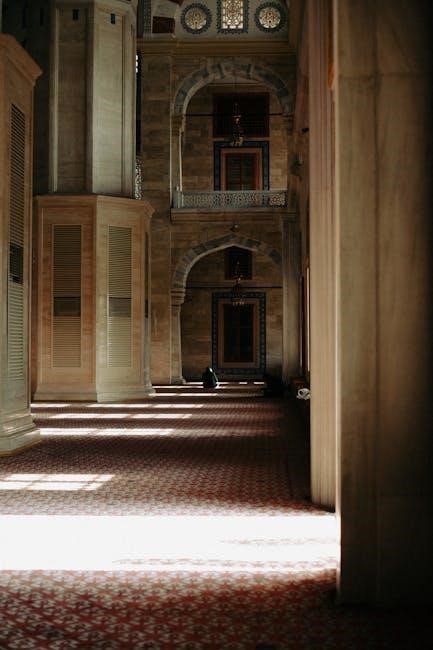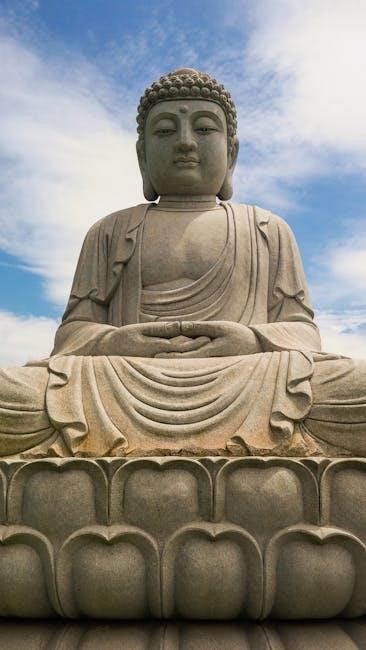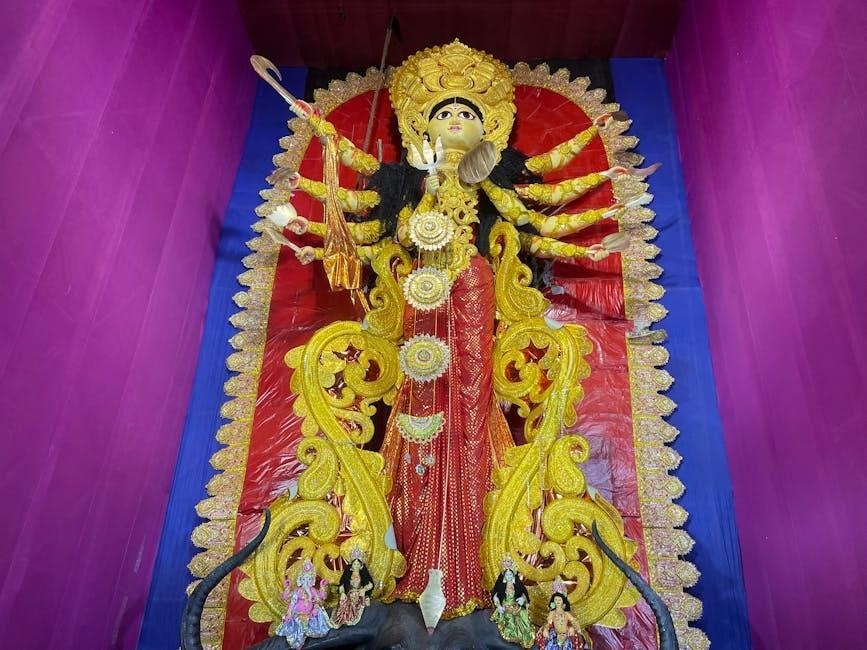
The Holy Koran of the Moorish Science Temple, authored by Noble Drew Ali, serves as a sacred text for Moorish Americans, blending Islamic principles with unique teachings on racial identity, divine rights, and land inheritance, providing spiritual and legal guidance for its followers.
Overview of the Moorish Science Temple and Its Significance
The Moorish Science Temple is a religious and civic movement founded in the early 20th century, primarily among African Americans. It emphasizes spiritual upliftment, cultural identity, and community empowerment. The movement blends elements of Islam, Freemasonry, and Black nationalism, creating a unique framework for self-determination. The Holy Koran of the Moorish Science Temple serves as its central text, offering teachings on unity, justice, and divine law. The Temple’s significance lies in its role as a catalyst for racial pride and self-reliance during a time of societal oppression. Its teachings continue to inspire modern movements focused on identity, justice, and collective advancement.
The Role of the Holy Koran in Moorish Science
The Holy Koran of the Moorish Science Temple serves as the central religious and philosophical text of the movement. It provides moral, spiritual, and cultural guidance, emphasizing unity, justice, and divine law. The text is not only a religious scripture but also a tool for cultural and historical education, helping adherents connect with their Moorish heritage. Its teachings are integral to rituals, ceremonies, and daily life, offering a framework for ethical living and community building. The Koran’s role extends beyond spirituality, as it empowers individuals to seek self-reliance and collective advancement, making it a cornerstone of Moorish Science and identity.

Historical Background of the Moorish Science Temple
The Moorish Science Temple was founded in the early 20th century by Noble Drew Ali, aiming to empower African Americans through Moorish identity and justice.
The Founding by Noble Drew Ali
Noble Drew Ali, born Timothy Drew, founded the Moorish Science Temple in 1913 in Newark, New Jersey. He aimed to uplift African Americans by reconnecting them with their Moorish heritage and divine identity. Drew Ali taught that African Americans were descendants of the ancient Moors, emphasizing a connection to Islam and indigenous cultures. The Holy Koran of the Moorish Science Temple, distinct from the Quran, was central to his teachings, blending Islamic principles with African diasporic identity. His movement emphasized love, truth, peace, freedom, and justice, inspiring a sense of pride and self-determination among followers. The Temple grew rapidly, becoming a significant spiritual and cultural force during the 1920s.
The Moorish Science Temple’s Connection to Islam and Other Religions
The Moorish Science Temple blends elements of Islam, Christianity, and other spiritual traditions, creating a unique syncretic faith. While it draws heavily from Islamic teachings, it diverges by incorporating African diasporic identity and cultural practices. The Holy Koran of the Moorish Science Temple reflects this blend, emphasizing universal truths and moral guidance. It shares similarities with Orthodox Islam, such as the belief in one deity and moral accountability, but adapts these principles to address the experiences of African Americans. The Temple also incorporates elements from Freemasonry and Pan-Africanism, offering a holistic spiritual and cultural framework for its followers. This eclectic approach fosters a sense of unity and empowerment.

The Holy Koran of the Moorish Science Temple: Key Teachings
The Holy Koran emphasizes divine wisdom, moral laws, and the unity of all people under one God, fostering empowerment and enlightenment through its teachings.
Core Principles and Beliefs
The Moorish Science Temple’s Holy Koran outlines core principles centered on the oneness of God, the unity of humanity, and the importance of divine truth and self-discovery. It emphasizes the elevation of the Moorish people, particularly those of African descent, through the restoration of their nationality and divine identity. The text teaches the principles of love, justice, and equality, urging adherents to live in harmony with natural and moral laws. It also highlights the importance of spiritual and material balance, promoting a life of righteousness and purpose. These beliefs aim to empower individuals to reclaim their heritage and fulfill their divine destiny.

Comparison with the Quran of Orthodox Islam
The Holy Koran of the Moorish Science Temple differs significantly from the Quran of orthodox Islam in structure and content. While both texts share themes of divine guidance and moral principles, the Moorish Koran is shorter and divided into 64 chapters, unlike the 114 surahs of the Islamic Quran. It is written in English and tailored to address the spiritual and cultural needs of the Moorish people. The Moorish text incorporates unique doctrines, such as the emphasis on Moorish identity and the connection of African descendants to Islam, which are not found in orthodox Islamic teachings. Despite these differences, both texts emphasize unity, justice, and righteousness.
TheConcept of Divine Revelation in the Moorish Koran
The Moorish Koran is presented as a divine revelation tailored to the Moorish people, emphasizing unity, justice, and the upliftment of African descendants. It is seen as a sacred text revealed to Noble Drew Ali, guiding followers to reclaim their true identity and connection to their Moorish heritage. The concept of divine revelation in the Moorish Koran highlights its role as a source of spiritual and moral guidance, blending elements of Islam, Christianity, and esoteric teachings. This revelation is viewed as a means to empower the Moorish people, aligning them with their national and divine mission. The text is regarded as a living guide for truth and justice.
Structure and Content of the Holy Koran
The Moorish Koran is structured into chapters and verses, blending moral, spiritual, and nationalistic teachings; It emphasizes Moorish identity and divine purpose, accessible in PDF for study.
Organization into Chapters and Verses
The Holy Koran of the Moorish Science Temple is structured into 64 chapters, each containing a series of verses. This organization mirrors traditional religious texts, facilitating easy reference and study. The chapters are thematic, addressing topics such as righteousness, unity, and divine law. Verses within each chapter are concise, often serving as moral or spiritual guidelines. The text is designed to be accessible, with clear divisions that enhance comprehension. This structured format allows adherents to navigate the teachings effortlessly, making it a practical guide for daily life and spiritual growth. The PDF version maintains this organization, preserving the text’s original intent and structure for modern readers.
Unique Aspects of the Moorish Koran’s Text
The Holy Koran of the Moorish Science Temple contains unique teachings distinct from other religious texts. It blends elements of Islam, Christianity, and esoteric knowledge, offering a synthesis of spiritual and cultural truths. The text emphasizes the unity of all peoples and the importance of righteousness, while also addressing themes specific to the Moorish identity. Its language is often more accessible than traditional religious texts, making it easier for readers to grasp its message. The Moorish Koran also incorporates prophetic insights and moral lessons tailored to guide its followers toward self-improvement and collective upliftment. These unique aspects make it a distinctive and impactful spiritual text.

The Significance of Circle 7 in the Moorish Koran
The Circle 7 holds profound symbolic and spiritual significance in the Moorish Koran, representing divine completeness and perfection. It is often linked to the seven days of creation, symbolizing the fulfillment of divine plans. The number 7 also reflects the seven principles of Moorish Science, which guide followers toward righteousness and unity. Circle 7 embodies the idea of a covenant between the divine and humanity, emphasizing harmony and balance. Its inclusion in the text underscores the connection between spiritual and numerical truths, offering followers a deeper understanding of their faith and its universal principles. This symbol is central to Moorish teachings and identity.
The Moorish Koran and Its Relation to the Bible
The Moorish Koran draws parallels with biblical themes while offering distinct interpretations, blending universal truths with Moorish Science principles, creating a unique spiritual framework.
Connections Between Moorish Teachings and Biblical Scriptures
The Moorish Koran shares thematic and symbolic connections with biblical scriptures, emphasizing universal truths such as divine justice, equality, and the importance of righteous living. Both texts highlight the struggle between good and evil, with the Moorish Koran often reinterpretting biblical narratives through a Moorish lens. Concepts like the Circle 7 and the number 7’s significance appear in both traditions, symbolizing completion and divine order. While the Moorish Koran does not directly quote the Bible, it complements its teachings by offering unique perspectives on similar themes, such as salvation, divine purpose, and the unity of all people under one Creator.
Interpretation of Biblical Themes in the Moorish Koran
The Moorish Koran reinterpret biblical themes through a unique lens, blending spiritual and cultural perspectives. It draws parallels between biblical figures and Moorish prophets, emphasizing unity and divine law. For instance, the story of Jesus is recontextualized to align with Moorish teachings on righteousness and justice. Similarly, the fall of man in Genesis is mirrored in the Koran’s narrative of the Moors’ divergence from their divine status. This reinterpretation serves to empower adherents, asserting their identity and purpose. The text encourages a deeper understanding of biblical truths while infusing them with Moorish wisdom, creating a synthesis that fosters spiritual and cultural awakening.
Trust, Title, and Land Inheritance in Moorish Teachings
The Moorish Science Temple teaches that trust, title, and land inheritance are divine covenants, emphasizing the importance of metes and bounds as sacred boundaries set by the Creator.
The Concept of Trust in Moorish Science
The concept of trust in Moorish Science is deeply rooted in the teachings of the Holy Koran of the Moorish Science Temple. It emphasizes faith in the Divine and the fulfillment of one’s duties as a sacred responsibility. Trust is seen as a covenant between the individual and the Divine, fostering spiritual growth and accountability. This principle extends to community relationships, where trust among members is essential for unity and collective progress. The Moorish Koran encourages believers to trust in the wisdom of Allah and to uphold their commitments with integrity, reflecting both personal and communal fidelity to the Divine plan. This trust is a cornerstone of Moorish Science, guiding adherents toward righteousness and self-determination.
Understanding Metes and Bounds in the Moorish Koran
The concept of “metes and bounds” in the Moorish Koran refers to the spiritual and physical boundaries that define the inheritance and divine rights of the Moorish people. Rooted in the teachings of Noble Drew Ali, these terms emphasize the importance of understanding one’s rightful place within the cosmos and society. Metes and bounds symbolize the limits of authority, land, and cultural identity, urging followers to reclaim their heritage and respect the divine order. This principle is both practical and metaphorical, guiding Moors to assert their sovereignty and fulfill their destiny as a nation. It underscores the Koran’s emphasis on justice, unity, and the restoration of Moorish identity.
Legal and Spiritual Implications of Land Inheritance
The Holy Koran of the Moorish Science Temple emphasizes the divine right of land inheritance, linking it to both legal and spiritual responsibilities. It teaches that land is a sacred trust granted by the Most High, with boundaries (metes and bounds) established for each nation. Legally, this implies a covenant to honor territorial rights, while spiritually, it signifies stewardship over the earth. The text underscores the importance of respecting these boundaries to maintain harmony and justice. Disregarding these principles is seen as a violation of divine law, leading to imbalance and strife. Thus, land inheritance is not just a material matter but a deeply spiritual obligation.
Modern Availability and Study of the Moorish Koran
The Holy Koran of the Moorish Science Temple is widely available in PDF format, enabling easy digital access for study and reflection. This version preserves the original teachings, making it a valuable resource for both members and scholars. The PDF format ensures accessibility across devices, fostering global dissemination of Moorish Science principles.

The Holy Koran of the Moorish Science Temple in PDF Format

The Holy Koran of the Moorish Science Temple is widely available in PDF format, making it accessible for study and reflection. This digital version preserves the original teachings of Noble Drew Ali, ensuring their message endures for future generations. Many adherents and scholars appreciate the convenience of the PDF, which allows for easy sharing and reference. While the physical copy remains sacred, the PDF format has become a popular tool for those seeking to explore Moorish Science. However, it is often emphasized that true understanding requires guidance from Moorish elders and community study. The PDF serves as a valuable resource for both personal and collective spiritual growth.
Study Guides and Resources for Understanding the Text

Several study guides and resources are available to aid in understanding the Holy Koran of the Moorish Science Temple. Official study guides published by the Moorish Science Temple provide detailed explanations of key concepts and verses. Additionally, annotated versions of the Moorish Koran in PDF format offer insights into its teachings. Online forums and communities dedicated to Moorish Science discuss interpretations and historical context. Video lectures by Moorish scholars further elaborate on complex themes. Mobile apps and e-books also make studying convenient. These resources help followers and scholars alike deepen their understanding of the text’s spiritual and philosophical foundations.

Contemporary Relevance and Applications of Moorish Teachings
The Holy Koran of the Moorish Science Temple remains a vital text for modern spiritual and social movements. Its teachings on identity, justice, and unity resonate deeply in today’s diverse world. Many find inspiration in its emphasis on self-discovery and empowerment, particularly within communities seeking cultural and historical restoration. The principles of Moorish Science are applied in activism, education, and personal development, bridging spiritual growth with practical action. Additionally, the text’s focus on community building and collective upliftment aligns with contemporary efforts to address systemic inequalities. Its relevance endures as a guide for navigating modern challenges while honoring ancestral wisdom.
The Holy Koran of the Moorish Science Temple remains a vital spiritual guide, inspiring unity, justice, and divine truth. Its teachings continue to empower individuals and communities globally.
The Enduring Legacy of the Moorish Science Temple
The Moorish Science Temple has left a profound and lasting impact on spiritual and cultural movements. Founded by Noble Drew Ali, the organization emphasized unity, self-empowerment, and the rediscovery of Moorish identity. Its teachings, centered around the Holy Koran of the Moorish Science Temple, have inspired generations to embrace their heritage and strive for justice. The temple’s legacy is evident in its influence on modern spiritual and social movements, fostering a sense of community and resilience. Its principles continue to guide individuals in their pursuit of truth and enlightenment, ensuring the Moorish Science Temple’s enduring relevance in contemporary society.
The Holy Koran’s Impact on Modern Spiritual Movements
The Holy Koran of the Moorish Science Temple has significantly influenced modern spiritual movements by blending Islamic, Christian, and Indigenous teachings. Its emphasis on racial empowerment and divine identity resonates with contemporary groups seeking cultural and spiritual renewal. The text’s accessibility in PDF format has facilitated its global dissemination, inspiring movements focused on social justice and self-determination. Many modern spiritual leaders draw parallels between its teachings and current struggles for equality, making it a cornerstone for those exploring alternative religious frameworks. Its unique synthesis of traditions continues to foster dialogue and unity across diverse spiritual communities.

References and Further Reading
To delve deeper into the teachings and history of the Holy Koran of the Moorish Science Temple, several resources are available; The text can be accessed in PDF format through official Moorish Science Temple of America (MSTA) publications or reputable online archives. For historical context, works by scholars like Charles D. Chavis and Ernest Allen Jr. provide insightful analysis. Additionally, “The Moorish Science Temple of America: Its Origin, History, Principles, and Program” by Noble Drew Ali offers foundational knowledge. These resources, along with study guides, aid in understanding the text’s spiritual and cultural significance. Ensure to verify sources for accuracy and authenticity.
Leave a Reply
You must be logged in to post a comment.